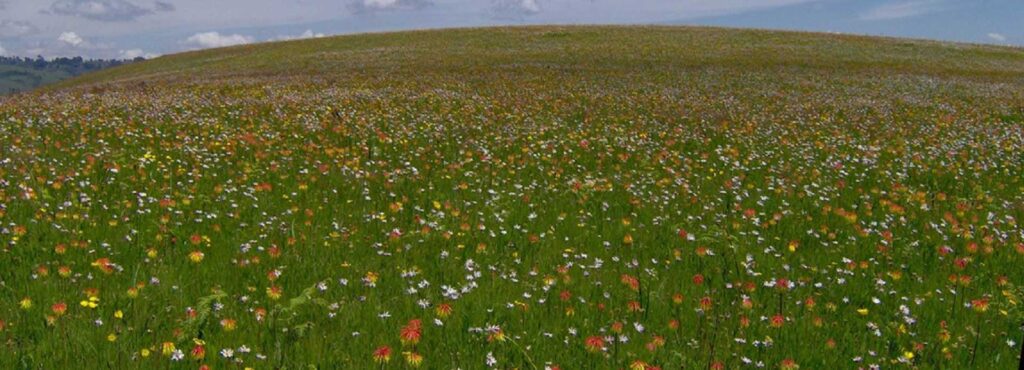Known locally as Bustani ya Mungu, translating to “the Garden of God,” Kitulo Plateau National Park is a haven for botanists and nature enthusiasts alike. Nestled amidst the fertile volcanic soil, this park is a vibrant tapestry of colorful orchids, lobelias, and lilies, creating a stunning Serengeti of flowers. Beyond its botanical wonders, Kitulo is a paradise for birdwatchers and butterfly enthusiasts, with numerous endemic species gracing the open grasslands.

A Brief History of Kitulo
In 1870, explorer Fredrick Elton first set foot in the region that would later become Kitulo National Park. Fast forward to the 1960s, the United Nations Food and Agriculture Organization took control of the area for Wheat and Sheep Schemes, which proved unsuccessful. Repurposed as a dairy farm in 1972, the land still functions as one today.
Responding to conservation concerns, Kitulo National Park was established on September 16, 2005, encompassing portions of the Livingstone and Nhumbe Forest Reserves.
Climate at Kitulo Plateau
The park enjoys a moderate climate influenced by altitude and Lake Nyasa. From December to April, temperatures range from 14.5°C to 18°C, with minimums as low as 0.5°C in June and August. The annual rainfall averages 1600mm, primarily during the rainy season from October to May.
Getting There: By Air and By Road
Kitulo is approximately 110 kilometers from Mbeya town, accessible by 4×4 vehicles. The park is exclusively reachable by road, with Songwe Airport 90 kilometers away, providing air access.
- By Road: Options include routes via Chimala (103 kilometers from Mbeya), Isyonje (70 kilometers from Mbeya), and Njombe town to Ikonda-Makete-Kitulo (165 kilometers).
- By Air: Songwe Airport facilitates air travel to Kitulo, offering a convenient alternative to road transport.
Attractions Within Kitulo National Park
1. Plateau Kitulo
The plateau hosts three main plant categories:
- Aster transaniesis, Kniphofia Grantii, and others in well-drained grasslands.
- Bogs with flora like Lobelia and Gladiolus.
- Rocky ridges with Moraea callista and Romulea companuloides.
2. Flowers
Boasting over 40 ground orchid species, Kitulo transforms into a captivating flower garden, particularly from late November to early April.
3. Forest of Mount Livingstone
Featuring tree species like Hagenia abyssinica and Juniperus procera, this forest adds to Kitulo’s biodiversity.
4. Valley of Nhumbe
Streams, waterfalls, and the Juniper woodland in this valley contribute to Kitulo’s diverse landscape.
5. Waterfall Usalama
Standing at approximately 100 meters, this waterfall is a captivating sight, located 20 kilometers from Mwakipembo’s main gate.
Bird Watching
Kitulo is an Important Bird Area (IBA) and a wintering ground for various South African and European species. Abdim’s stock, Blue swallow, and Denham’s bustard are among the indigenous bird species.
Outside the Park Attractions
- Accommodation: Options include public campsites like Mwakipembo Public Campsite and reserved areas like Maua Special Campground.
- Tourism-Related Activities: Hiking, nature walks, bird viewing, camping, filming, and cycling are available activities, each offering a unique perspective on Kitulo’s beauty.
Tourism Activities in Kitulo
1. Hiking Trails:
- Trail of the Nhumbe (1–3 hours): Discover the Nhumbe forest, colobus monkeys, and waterfalls.
- Matamba Ridge (4–10 hours): Offers stunning views of grassy plains and horizons.
- Kipunji Hiking Trail (8-12 hours): Explores the peaks and grassland plains of Mount Livingstone.
- Kilasi Hiking Route (3-6 hours): Unveils the beauty of Kilasi.
- Bamboo Hiking Trek (3-6 hours): Explores bamboo-filled landscapes.
- Ikubo Hiking Trail (3-6 hours): Takes you on a journey through Ikubo.
- Ipelele to Matema Beach-Lake Nyasa Trail: A multi-day trek with diverse landscapes.
2. Game Drives: Explore Matamba Ridge, bamboo forests, Mount Livingstone trees, waterfalls, and a wild floral garden on a game drive.
Discover the Beauty of Kitulo
Whether you’re captivated by the diverse flora, enchanted by the birdlife, or seeking adventure through hiking trails, Kitulo Plateau National Park promises an unforgettable experience. With its rich history, unique climate, and varied attractions, this Garden of God is a hidden gem in Tanzania, waiting to be explored.
